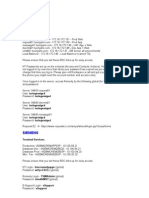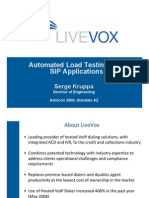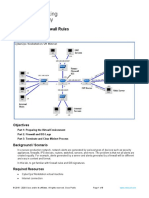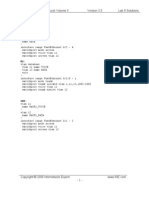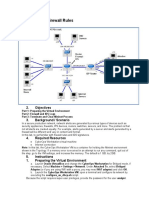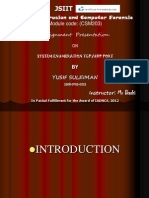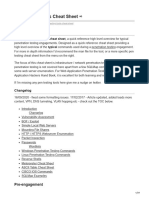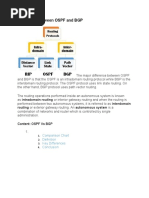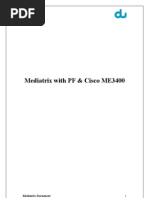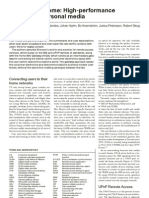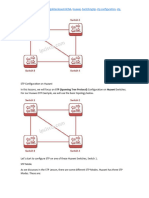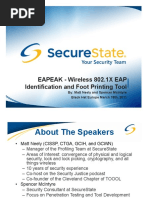Sipp
Sipp
Uploaded by
mishrasaroj05Copyright:
Available Formats
Sipp
Sipp
Uploaded by
mishrasaroj05Copyright
Available Formats
Share this document
Did you find this document useful?
Is this content inappropriate?
Copyright:
Available Formats
Sipp
Sipp
Uploaded by
mishrasaroj05Copyright:
Available Formats
tomeko.
net
Sipp cheatsheet
Sipp is a free test tool and traffic generator for the SIP protocol. It uses XML format files to define test scenarios.
ENGLISH VERSION WERSJA POLSKA Sitemap PROJEKTY PROGRAMY NARZDZIA ONLINE INNE Code Snippets Sipp LPT WinXP Avrdude/MinGW Linki Co nowego? Kontakt
General usage: sipp remote_host[:remote_port] [options]
Some important command-line options:
-sf filename Load test scenario from specified file. -inf filename Use CSV file to insert data substituted for [field0], [field1], etc into XML scenario. First line of file describes order of inserting field sets (SEQUENTIAL/RANDOM/USE). -sn name Use one of the embedded, predefined scenarios like "uac", "uas". -r rate Scenario execution rate, default value = 10 times per period, default period = 1000 ms. -rp period Scenario execution period [ms], combined with execution rate. Execution rate is combined of rate and period parameters, i.e. if period = 3500 and rate = 7 there will be 7 calls in 3.5 s. -t transport mode Set the transport mode: "u1" - UDP, one socket (default), "un" - UDP, one socket per call, other modes (TCP and with compression) available. -max_socket max Set the limit for simultaneously used sockets (for one socket per call mode). If limit is reached, sockets are reused. -m calls Stop and exit after specified tests count. -s service Set user part of the request URI (default: 'service'). Replaces [service] tag in XML scenario file. -ap pass Set password used for auth challenges (default: 'password'). -l limit Limit simultaneous calls (default: 3 * call_duration (s) * rate). -trace_msg Log sent and received SIP messages (file: scenario_pid_messages.log). -trace_err Log error message to file (like "Discarding message which can't be mapped to a known SIPp call").
Search
SLM, SLA Best Practices Learn SLM, SLA Basics and More. Get a Free Guide Now.
www.ITBusinessEdge.com/SLMGuide
Simple scenario files with usage
These scenario files were tested with sipp-win32-2009-06-06.
OPTIONS
Send OPTIONS message 5 times to 30@192.168.1.211.
sipp 192.168.1.211 -sf OPTIONS.xml -m 5 -s 30
Send OPTIONS message 30 times to 30@192.168.1.211 waiting 200 ms for 200/OK reply each time.
sipp 192.168.1.211 -sf OPTIONS_recv_200.xml -m 30 -s 30
REGISTER
Register to 192.168.1.106 using parameters from CSV file. If CSV file has more than one entry you can increase simultaneous call limit (-l option).
sipp 192.168.1.106 -sf REGISTER_client.xml -inf REGISTER_client.csv -m 1 -l 1 -trace_msg -trace_err
converted by Web2PDFConvert.com
REGISTER + SUBSCRIBE application/dialog-info+xml (BLF)
Register to 192.168.1.211 using parameters from CSV file and start dialog-info subscription (RFC4235).
sipp 192.168.1.211 -sf REGISTER_SUBSCRIBE_client.xml -inf REGISTER_SUBSCRIBE_client.csv -m 100 -l 2 -r 2
REGISTER + INVITE
SIPp is simulating 3 UACs, each one of them is making outgoing call. This scenario expects calls to be answered. Call targets are 3 other UACs configured to auto answer and play wav file (single pjsua instance with 3 accounts).
pjsua_vc6d --local-port=5068 --id sip:33@192.168.1.211 --registrar sip:192.168.1.211 --proxy sip:192.168.1.211 --realm * --username 33 --password 33 --next-account --id sip:34@192.168.1.211 --registrar sip:192.168.1.211 --proxy sip:192.168.1.211 --realm * --username 34 --password 34 --next-account --id sip:35@192.168.1.211 --registrar sip:192.168.1.211 --proxy sip:192.168.1.211 --realm * --username 35 --password 35 --play-file file.wav --auto-answer 200 --auto-play
Each call is disconnected after 30 s. Call limit is this time smaller than number of CSV entries to avoid multiple calls to single target.
sipp 192.168.1.211 -sf REGISTER_INVITE_client.xml -inf REGISTER_INVITE_client.csv -m 100 -l 2 -r 1 -rp 10000
REGISTER UAS + SUBSCRIBE application/dialog-info+xml (BLF) UAS
Little tricky scenario that requires two actual scenario files. Sipp is simulating registration and BLF subscription server that immediately terminates subscription with reason=noresource. 1) With tested UAC create registration account 30@your_pc_ip_address, no password. Create dialog-info+xml subscription for 108@your_pc_ip_address. 2) Run UAS REGISTER scenario and wait for the phone to log in. 3) Break REGISTER scenario by hitting Ctrl+C and run UAS SUBSCRIBE scenario.
sipp -sf uas_register.xml sipp -sf uas_subscribe.xml
REGISTER UAC + INVITE + DTMF INFO
1) SIP registration with authorization. 2) Calling number 110. In my test extension 110 is FXS and is looped back to FXO port and call is answered by DISA. 3) Dialing another 3-digit number using SIP INFO DTMF (Content-Type: application/dtmf-relay in this scenario). Call is not answered. 4) Disconnecting. Note: if using "application/dtmf" Content-Type (message body consisting of dtmf only) sign "*" should be encoded as "10" and "#" as "11".
sipp 192.168.1.211 -sf REGC_INVITE_INFO.xml -inf REGC_INVITE_INFO.csv -m 5 -l 1 -r 1 -rp 10000
SIP digest leak test
converted by Web2PDFConvert.com
SIP digest leak is a SIP phone vulnerability that allows attacker to get digest response from a phone and use it to guess password using brute-force method described first on enablesecurity.com page. Here are required steps: 1. 2. 3. 4. 5. 6. attacker calls phone (direct IP call) sending INVITE frame, callee picks up phone, connection is confirmed by both sites, attacker does not send any RTP frames (at least does not have to) and just waits, callee hangs up phone sending BYE request (probably throwing some profanities), in response to BYE attacker sends SIP/401 or 407 message (authentification request), if attack is successfull callee is sending BYE again with Authorization: Digest header added.
At this point attacker has authentification challenge (sent by him with 401/407 message) and response (received with last BYE). Most likely there will be simplest SIP/2.0 authentification scheme used (RFC2069):
ha1 = MD5(username ":" realm ":" password) ha2 = MD5(method ":" req_uri) response = MD5(ha1 ":" nonce ":" ha2)
Assuming that username and realm are known attacker can now use brute-force method to guess user password. There are few conditions that have to be met to make this scheme work: SIP phone has to respond to authentication challenges sent by other sources than registration server(s) it is using (as a note it works with one hardware phone and one softphone I've tested (and those were all user agents I've tested)), phone SIP port has to accessible to attacker, usally phone will be placed behind the Restricted Cone NAT and port would not be forwarded, attacker would most likely have to know username and authentication realm used by target; for better security you probably should not leave "realm" configuration field of SIP phone empty (it could respond to challenges with any realm then making it easier to prepare attack), guessing password through brute-fource would be time consuming or almost impossible for more complex passwords.
sipp 192.168.1.211 -sf uac_digest_leak.xml -s 30 -m 1
Example result: digest_leak.log.
Generating calls using G.729 codec
If you ever had to make high-load call or even single-call tests with G.729(a) codec then you may find out that finding a free softphone with G729a capability is not an easy task. Obviously pjsua would be good choice, but it require downloading DirectX SDK, Intel Performance Primitives package and rebuilding from sources, so it would take few hours to get working binary. Another option is capturing RTP stream using Wireshark and playing it back when generating or receiving calls with SIPp. Here is .pcap file with 2 minutes of G.729 RTP stream. This is actually recorded connection with some voice mail system. Extract this file to \pcap subdirectory of SIPp. Included scenario is UAC call, to get credible load test results you can call i.e. some DISA or auto-attendant lines that will play some announcement back.
sipp 192.168.1.211 -sf uac_pcap_G729.xml -l 1 -m 10
Asterisk FreePBX Hosting Fully featured and private PBX ultra high speed connection vps.powerpbx.org Force Calibration Device Calibrate load with this new device 15% discount on online orders! www.engineeringhelper.com OnSIP Hosted PBX The complete phone system replacement and so much more! www.onsip.com
"Cookie monsters": 299886 Parse time: 0.506 s
converted by Web2PDFConvert.com
You might also like
- Network Security All-in-one: ASA Firepower WSA Umbrella VPN ISE Layer 2 SecurityFrom EverandNetwork Security All-in-one: ASA Firepower WSA Umbrella VPN ISE Layer 2 SecurityNo ratings yet
- UCPros SIP TS LAB - v1.1Document9 pagesUCPros SIP TS LAB - v1.1vbugaianNo ratings yet
- SIPp IntroductionDocument30 pagesSIPp IntroductionAlbert Etsebeth100% (2)
- A Nice OSCP Cheat SheetDocument12 pagesA Nice OSCP Cheat Sheetdss77750% (2)
- 300-135 TSHOOT Study GuideDocument272 pages300-135 TSHOOT Study GuideLuke RobertsonNo ratings yet
- Hacking VoIP ExposedDocument57 pagesHacking VoIP ExposedarafatasgharNo ratings yet
- Sip Phone CmeDocument13 pagesSip Phone Cmeyerima1100% (2)
- CallManager Express - SIP/SCCPDocument5 pagesCallManager Express - SIP/SCCPDenis Alberto Rodríguez GonzálezNo ratings yet
- Updated Login List1Document6 pagesUpdated Login List1Pamela Thobi100% (2)
- Task 1.1: CCIE Voice Lab Workbook Volume II Lab 9 SolutionsDocument79 pagesTask 1.1: CCIE Voice Lab Workbook Volume II Lab 9 SolutionsLuis SeverinoNo ratings yet
- PenTest ToggmeisterDocument26 pagesPenTest ToggmeisterthefinnNo ratings yet
- LiveVox Serge Kruppa Astricon 2008 4Document41 pagesLiveVox Serge Kruppa Astricon 2008 4Niraj TamrakarNo ratings yet
- Android NGN Stack 00Document28 pagesAndroid NGN Stack 00Munib Ul HassanNo ratings yet
- Unlock IEWB VO VOL2.v3.00.Lab7.SolutionsguideDocument85 pagesUnlock IEWB VO VOL2.v3.00.Lab7.SolutionsguideLuis SeverinoNo ratings yet
- SBCDocument21 pagesSBCLazaNo ratings yet
- General TipsDocument3 pagesGeneral Tipshitdura12No ratings yet
- Cisco Spiad - LabDocument48 pagesCisco Spiad - LabVicJ1992No ratings yet
- 26.1.7 Lab - Snort and Firewall RulesDocument8 pages26.1.7 Lab - Snort and Firewall RulesRana Elwan100% (1)
- Unlock IEWB VO VOL2.v3.00.Lab8.SolutionsguideDocument79 pagesUnlock IEWB VO VOL2.v3.00.Lab8.SolutionsguideLuis SeverinoNo ratings yet
- Siproxd Users Guide: Thomas RiesDocument30 pagesSiproxd Users Guide: Thomas RiesLakshmanan SivalingamNo ratings yet
- Sip Notes NewDocument7 pagesSip Notes Newwin_ramanNo ratings yet
- 26.1.7lab - Snort and Firewall RulesDocument7 pages26.1.7lab - Snort and Firewall RulesThái NguyễnNo ratings yet
- 26.1.7 Lab - Snort and Firewall Rules - ILMDocument9 pages26.1.7 Lab - Snort and Firewall Rules - ILMmarlonkillianlouisaNo ratings yet
- 26.1.7 Lab - Snort and Firewall RulesDocument8 pages26.1.7 Lab - Snort and Firewall RulesFata HasanNo ratings yet
- Snort and Firewall Rules-1Document9 pagesSnort and Firewall Rules-1Ruel AlejandroNo ratings yet
- SipDocument58 pagesSipअनिल वामनेNo ratings yet
- FpingDocument5 pagesFpingeraldodrugovichNo ratings yet
- Asterisk Advanced Lab Assignment: Building A Basic PBX Extensions SIP Phones Configuration FilesDocument10 pagesAsterisk Advanced Lab Assignment: Building A Basic PBX Extensions SIP Phones Configuration FilesFaisal Saeed SaeedNo ratings yet
- PhonerLite ConfigurationDocument1 pagePhonerLite Configurationbogdan6garagauNo ratings yet
- Comp 6204 Voip: Taridium Ipbx Express Free Edition 5 Users (Asterisk Based)Document14 pagesComp 6204 Voip: Taridium Ipbx Express Free Edition 5 Users (Asterisk Based)nathan fitnessNo ratings yet
- Basic F5 LTM Troubleshooting SSL Ciphersuits - Using Httpwatch and Long Run TcpdumpsDocument25 pagesBasic F5 LTM Troubleshooting SSL Ciphersuits - Using Httpwatch and Long Run TcpdumpsneoaltNo ratings yet
- The Arsenal, The Armorty and The LibraryDocument51 pagesThe Arsenal, The Armorty and The LibraryD Chris100% (1)
- Enumeration TestingDocument38 pagesEnumeration TestingYusifsuleimanNo ratings yet
- Hack Win XP With MSFDocument10 pagesHack Win XP With MSFpunzango73No ratings yet
- Client Gibraltar Server Comparison (Microsoft Design Document)Document24 pagesClient Gibraltar Server Comparison (Microsoft Design Document)illegal-manualsNo ratings yet
- Deasis Tech6Document9 pagesDeasis Tech6Mariah De asisNo ratings yet
- 12.1.1.7 Lab - Snort and Firewall RulesDocument9 pages12.1.1.7 Lab - Snort and Firewall RulesMuhammad TaufiqNo ratings yet
- Unlock IEWB VO VOL2.v3.00.Lab3.Solutionsguide.0.01Document83 pagesUnlock IEWB VO VOL2.v3.00.Lab3.Solutionsguide.0.01Luis SeverinoNo ratings yet
- Escuela Superior Politecnica Del LitoralDocument8 pagesEscuela Superior Politecnica Del Litoraldalinda cherubinNo ratings yet
- Assignment 1.3 - Linux Networking and Command Line Tools-2Document8 pagesAssignment 1.3 - Linux Networking and Command Line Tools-2Denis OsanyaNo ratings yet
- Práctica de Laboratorio 26.1.7Document10 pagesPráctica de Laboratorio 26.1.7rojas.saldana.armando.sptmNo ratings yet
- CEH - Certified Ethical Hacker Notes (Recovered)Document9 pagesCEH - Certified Ethical Hacker Notes (Recovered)Ostilio SystemsNo ratings yet
- Practicals 3Document5 pagesPracticals 3Tarik AmezianeNo ratings yet
- Telekom SIP Trunk - GermanyDocument7 pagesTelekom SIP Trunk - Germanyثائر هاني فرج اللهNo ratings yet
- Active DirectoryDocument10 pagesActive DirectoryKindraNo ratings yet
- VoipDocument24 pagesVoipvice pyNo ratings yet
- Lab - Snort and Firewall Rules: TopologyDocument9 pagesLab - Snort and Firewall Rules: TopologyЯрослав КостенкоNo ratings yet
- 26.1.7 Lab - Snort and Firewall RulesDocument17 pages26.1.7 Lab - Snort and Firewall RulesLISS MADELEN TRAVEZ ANGUETANo ratings yet
- How To Integrate NodebDocument14 pagesHow To Integrate NodebCluster Manager IIINo ratings yet
- Points SipforumDocument41 pagesPoints SipforumsujathasubbiahNo ratings yet
- Understanding Sip TracesDocument16 pagesUnderstanding Sip TracesMichael KoenigNo ratings yet
- Kumon FortigateDocument11 pagesKumon FortigatehafizizwanNo ratings yet
- Itsp PDFDocument7 pagesItsp PDFEzo'nun BabasıNo ratings yet
- F5 101 NotesDocument11 pagesF5 101 NotesManjunath Shekar SinghNo ratings yet
- Pen Testing Tools Cheat SheetDocument39 pagesPen Testing Tools Cheat Sheetsetyahangga3No ratings yet
- Ans: The Four Things That Are Need To Be Kept in Mind Are A. Framing B. Line-Coding C. Switch Type D. Clock SourceDocument7 pagesAns: The Four Things That Are Need To Be Kept in Mind Are A. Framing B. Line-Coding C. Switch Type D. Clock Sourcesumit rustagiNo ratings yet
- Cisco Unified Communications Manager Express: Terminology SCCP Phone ConfigurationDocument3 pagesCisco Unified Communications Manager Express: Terminology SCCP Phone ConfigurationHugo Cesar Flores OrtizNo ratings yet
- Alerts To SyslogDocument25 pagesAlerts To SyslogVedran GorickiNo ratings yet
- CISCO PACKET TRACER LABS: Best practice of configuring or troubleshooting NetworkFrom EverandCISCO PACKET TRACER LABS: Best practice of configuring or troubleshooting NetworkNo ratings yet
- 07 Ethernet Switching BasicsDocument38 pages07 Ethernet Switching BasicsAdeyemiNo ratings yet
- CooVox U100 V2 - DatasheetDocument2 pagesCooVox U100 V2 - DatasheetAfiq AsyrafNo ratings yet
- Difference Between OSPF and BGP: Routing or Exterior Gateway Routing. An Autonomous System Is ADocument6 pagesDifference Between OSPF and BGP: Routing or Exterior Gateway Routing. An Autonomous System Is Ashrikant_more41612No ratings yet
- Design and Implementation of Test IP Network Intelligent Monitoring System Based On SNMPDocument4 pagesDesign and Implementation of Test IP Network Intelligent Monitoring System Based On SNMPAldrey PhadmaNo ratings yet
- Cisco Catalyst 3850 Series and Cisco Catalyst 3650 Series Switches Best Practices GuideDocument120 pagesCisco Catalyst 3850 Series and Cisco Catalyst 3650 Series Switches Best Practices Guidealessandro rosaNo ratings yet
- 812G 813G GigaHub ETSI PDFDocument4 pages812G 813G GigaHub ETSI PDFEduardo Andrés Chango CuencaNo ratings yet
- Nokia Broadband Network Gateway Evolution With Control and User Plane Separation Application Note enDocument13 pagesNokia Broadband Network Gateway Evolution With Control and User Plane Separation Application Note enmark.suanoNo ratings yet
- Mobile: 2.LTE Signaling Radio Bearer OverviewDocument33 pagesMobile: 2.LTE Signaling Radio Bearer OverviewIrfan KhanNo ratings yet
- Max318m2w-Idu 2Document2 pagesMax318m2w-Idu 2Samys ChipaNo ratings yet
- Mediatrix-VOIP Document V 1.0Document4 pagesMediatrix-VOIP Document V 1.0lukyme2No ratings yet
- GPRS Lecture 22Document21 pagesGPRS Lecture 22Puneet ManglaNo ratings yet
- BGP Lab: Building An Internet SimulatorDocument17 pagesBGP Lab: Building An Internet SimulatorAwabdeh 97No ratings yet
- Manual 5020MGC 01 04Document51 pagesManual 5020MGC 01 04consultachNo ratings yet
- Exam Questions ExamplesDocument5 pagesExam Questions ExamplesSuman DasNo ratings yet
- IEEE 802.11 and BluetoothDocument29 pagesIEEE 802.11 and BluetoothDr. Hitesh MohapatraNo ratings yet
- ICTNWK604 - Class Activity 8Document9 pagesICTNWK604 - Class Activity 8MitchNo ratings yet
- NNMi Introduction Slide InformativeDocument71 pagesNNMi Introduction Slide InformativeMohammad Danish NasimNo ratings yet
- Virtually at Home: High-Performance Access To Personal MediaDocument6 pagesVirtually at Home: High-Performance Access To Personal MediaPatrick BarneNo ratings yet
- STP Huawei ComandosDocument3 pagesSTP Huawei ComandosSantiago Miguel Tapia GuajardoNo ratings yet
- Adapting Voice For ATM Networks: A Comparison of AAL1 Versus AAL2Document16 pagesAdapting Voice For ATM Networks: A Comparison of AAL1 Versus AAL2Control A60No ratings yet
- LAB 4 - Create Server Farm Prototype To Test RSTP PDFDocument6 pagesLAB 4 - Create Server Farm Prototype To Test RSTP PDFvigneshNo ratings yet
- A Complete Beginners Tutorial On How To Create Esp32Document16 pagesA Complete Beginners Tutorial On How To Create Esp32Inacio DimitriNo ratings yet
- EAPEAK - Wireless 802.1X EAP Identification and Foot Printing ToolDocument25 pagesEAPEAK - Wireless 802.1X EAP Identification and Foot Printing Toolclu5t3rNo ratings yet
- Cablelabs Especificaciones Docsis 3 PDFDocument763 pagesCablelabs Especificaciones Docsis 3 PDFarielomzaNo ratings yet
- Laporan UjikomDocument7 pagesLaporan UjikomClara ReginaNo ratings yet
- CCNA3 ProjectDocument9 pagesCCNA3 ProjectMalik HaroonNo ratings yet
- Mikrotik Routeros Training Inter-NetworkingDocument25 pagesMikrotik Routeros Training Inter-Networkingakame fabriceNo ratings yet
- NSX-T Routing Deep Dive - How A Stateful Service Drastically Changes RoutingDocument16 pagesNSX-T Routing Deep Dive - How A Stateful Service Drastically Changes RoutingMudassir IqbalNo ratings yet
- Pan Os Administrator's Guide: Version 7.1Document918 pagesPan Os Administrator's Guide: Version 7.1Dasnary Garay TejedaNo ratings yet









